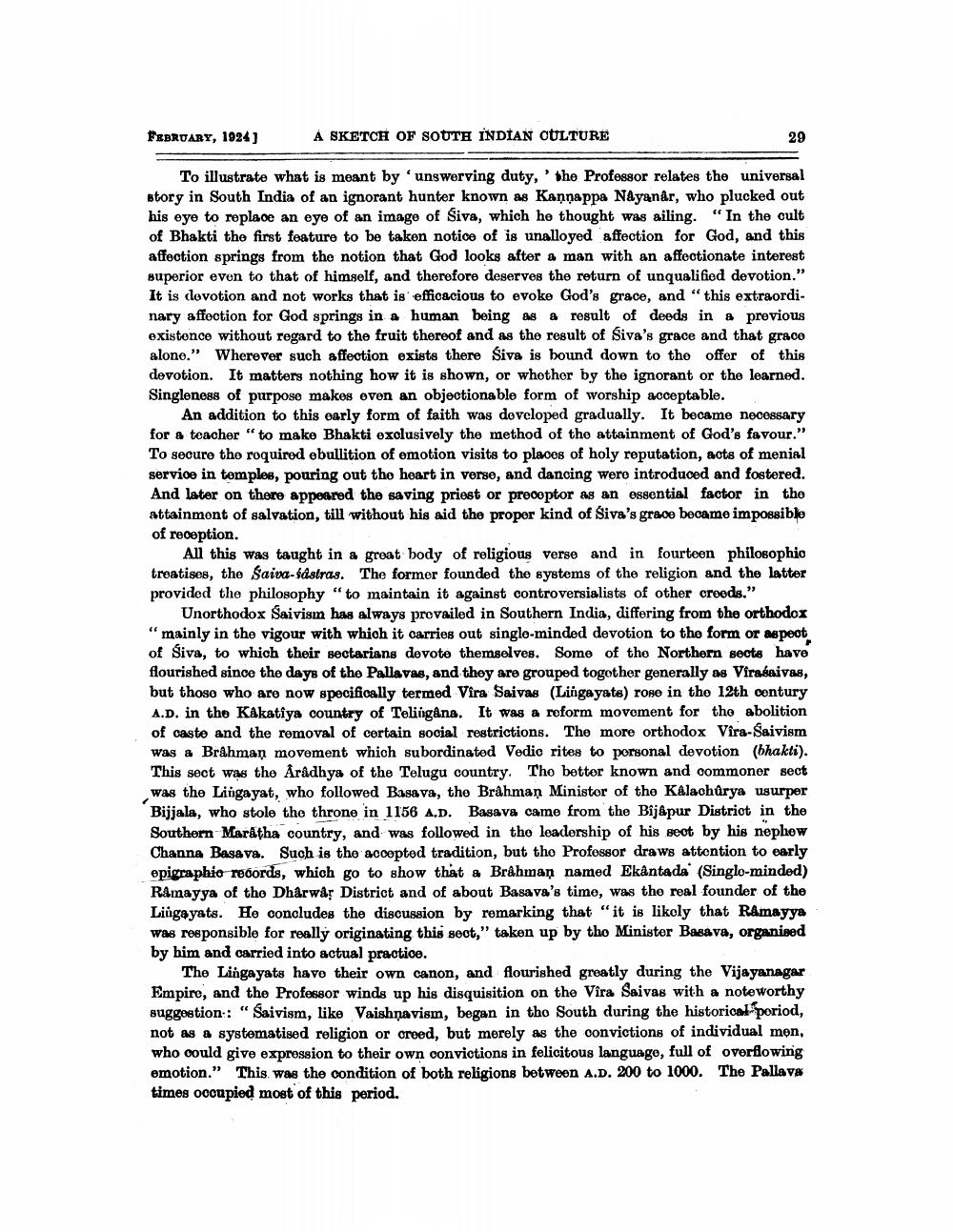________________
FEBRUARY, 1924)
Á SKETCH OF SOUTH INDIAN CULTURE
29
To illustrate what is meant by 'unswerving duty, 'the Professor relates the universal story in South India of an ignorant hunter known as Kannappa Nayanar, who plucked out his eye to replace an eye of an image of Siva, which he thought was ailing. “In the cult of Bhakti the first feature to be taken notice of is unalloyed affection for God, and this affection springs from the notion that God looks after a man with an affectionate interest superior even to that of himself, and therefore deserves the return of unqualified devotion." It is devotion and not works that is efficacious to evoke God's grace, and "this extraordinary affection for God springs in a human being as a result of deeds in a previous existence without regard to the fruit thereof and as the result of Siva's grace and that grace alone." Wherever such affection exists there Siva is bound down to the offer of this devotion. It matters nothing how it is shown, or whether by the ignorant or the learned. Singleness of purpose makes even an objectionable form of worship acceptable.
An addition to this early form of faith was developed gradually. It became necessary for a teacher " to make Bhakti exclusively the method of the attainment of God's favour." To secure the roquired ebullition of emotion visits to places of holy reputation, acts of menial service in temples, pouring out the heart in verse, and dancing were introduced and fostered. And later on there appeared the saving priest or procoptor as an essential factor in the attainmont of salvation, till without his aid the proper kind of Siva's grace became impossible of reception.
All this was taught in a great body of religious verse and in fourteen philosophio treatises, the Saiva-sdstras. The former founded the systems of the religion and the latter provided the philosophy "to maintain it against controversialists of other croeds."
Unorthodox Saivism has always prevailed in Southern India, differing from the orthodox "mainly in the vigour with which it carries out single-minded devotion to the form or aspect of Siva, to which their sectarians devote themselves. Some of the Northern sects have flourished since the days of the Pallaves, and they are grouped togother generally as Virasaivas, but those who are now specifically termed Vira Saivas (Lingayats) rone in the 12th century A.D. in the Kakatiya country of Telingana. It was a reform movement for the abolition of caste and the removal of certain social restrictions. The more orthodox Vira-Saivism was a Brahman movement which subordinated Vedic rites to porsonal devotion (bhakti). This sect was the Aradhya of the Telugu country. Tho better known and commoner sect was the Lingayat, who followed Basava, the Brahman Ministor of the Kalachůrya usurper Bijjala, who stole the throne in 1156 AD. Basava came from the Bijapur District in the Southern Maratha country, and was followed in tho leadership of his seot by his nephew Channa Basava. Such is the acceptod tradition, but the Professor draws attention to early epigraphio records, which go to show that a Brahman named Ekântada (Singlo-minded) Ramayya of the Dharwar District and of about Basava's time, was the real founder of the Lingayats. Ho concludes the discussion by remarking that "it is likoly that Ramayya was responsible for really originating this sect," taken up by the Minister Basava, organised by him and carried into actual practice.
The Lingayats have their own canon, and flourished greatly during the Vijayanagar Empire, and the Professor winds up his disquisition on the Vîra Saivas with a noteworthy suggestion: "Saivism, like Vaishnavism, began in tho South during the historical poriod, not as a systematised religion or creed, but merely as the oonvictions of individual mon, who could give expression to their own convictions in felicitous language, full of overflowing omotion." This was the condition of both religions between A.D. 200 to 1000. The Pallava times occupied most of this period.




